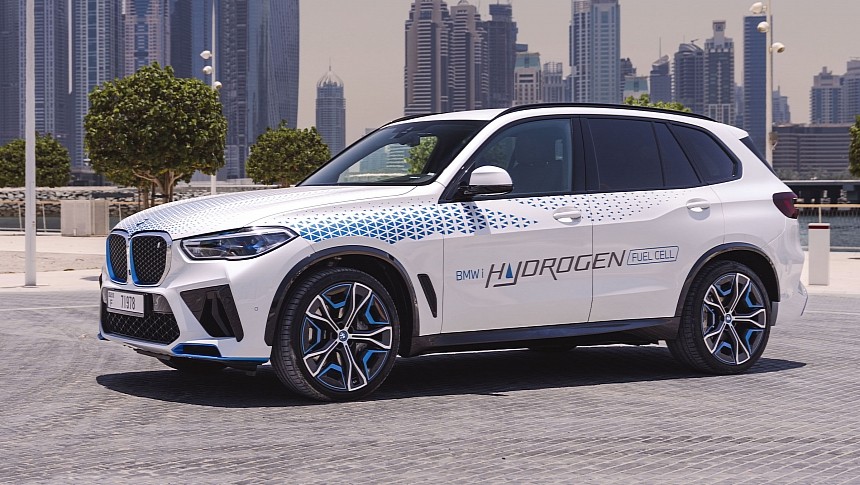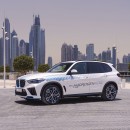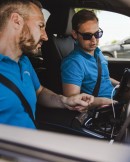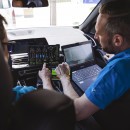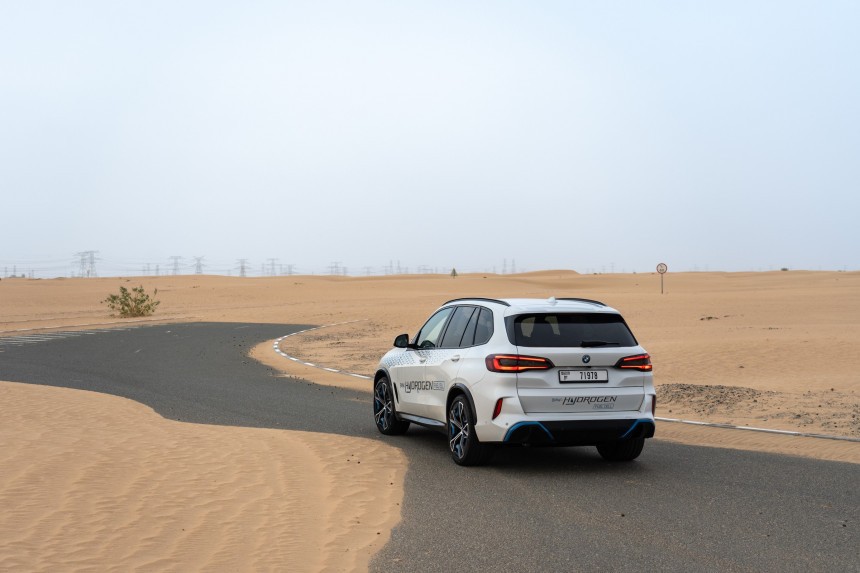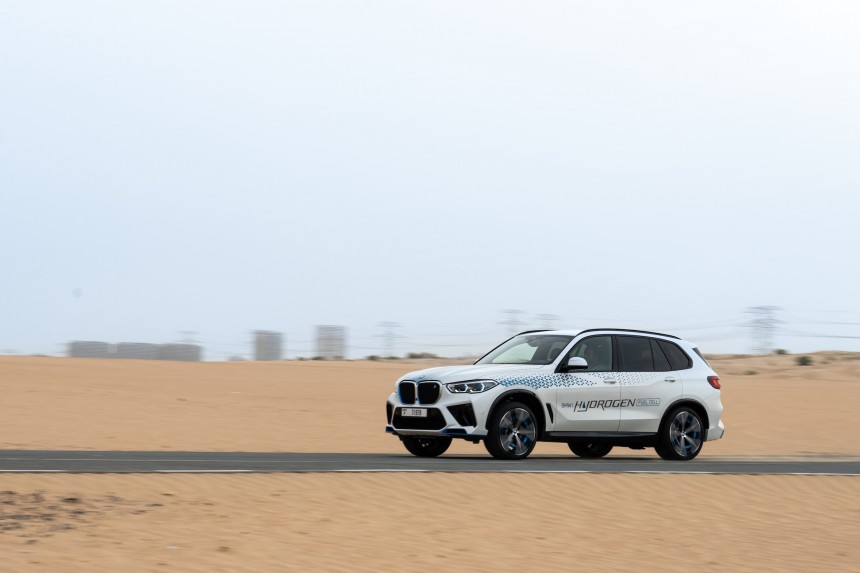BMW has taken the iX5 Hydrogen to Dubai for some hot weather testing. The territory of the United Arab Emirates is, this time of year, one of the hottest in the world. So, has the hydrogen-powered BMW passed the test?
During the day, the temperature goes as high as high as 113 degrees Fahrenheit (45 degrees Celsius) in Dubai. It sounds like the perfect place for BMW to take their hydrogen-powered iX5 for some hot-weather testing. Besides, sand, dust, significant fluctuations in humidity, and gradients are also factors that are worth putting the car against before it enters production. It is the first time the iX5 has gone to the United Arab Emirates, and the German carmaker claims it passed the test with flying colors.
The BMW development team wants to check how cooling is performed at such high temperatures and to make sure that, in extreme conditions, performance and range are not affected.
Back in February, a pilot fleet of nearly 100 cars was deployed around the world for testing across varying target user groups. They arrived in Europe, Japan, Korea, China, the United States, and the Middle East. The fleet also helps with the development of a refueling infrastructure based on a 700-bar refueling technology.
The BMW iX5 Hydrogen sports a powertrain, which integrates a hydrogen fuel cell stack that generates 167 horsepower (170 PS) from hydrogen and only emits pure water. There is also an electric motor that brings 228 horsepower (231 PS) into the equation, steered toward the rear axle for a total of 396 horsepower (401 PS) with systems combined. That is enough for a run from 0 to 100 kph (0-62 mph) in under 6 seconds.
The BMW testing team is aware that the hydrogen-powered cars have three aces up their sleeves: short refueling stops of up to 3 or 4 minutes, long-distance driving capability, and the locally emission-free driving.
The iX5 comes with a lithium-ion battery pack that can be recharged with the help of the motor’s brake energy recuperation and carbon-fiber reinforced plastic tanks for the hydrogen that supplies the fuel cell. Together, the two tanks store 6 kilograms (13.2 pounds) of hydrogen for a range of up to 504 kilometers (313 miles) on the WLTP testing standard.
The BMW iX5 will not be easily recognizable on the road. Blue accents and closed-off exhaust housings might trick people into thinking that they are dealing with a full electric car.
BMW previewed the hydrogen-powered X5 at the 2019 Frankfurt Motor Show under the I Hydrogen NEXT Concept designation, which BMW said that came to reduce dependence on critical raw materials such as cobalt, lithium, and nickel.
Hydrogen seems indeed to be a long-term fuel solution, and BMW has been reading between the lines. Alternative fuels can be a way out of decongesting the ever-suffocated metal industry that supplies battery manufacturers. BMW has been developing fuel technology in partnership with Toyota since 2012, based on a deal announced a year before. The Bavarians have also signed an agreement with General Motors more than a decade ago to fund hydrogen research.
Back in 2020, the German government kicked off an investment program rated at $9 billion, infused in the development of the hydrogen infrastructure across the country.
A big part of the hydrogen used today is produced by reforming natural gas, a procedure which releases carbon dioxide. Green hydrogen is instead extracted from water by electrolysis.
For instance, the Toyota Mirai is already in its second generation, with a range quoted at 400 miles (644 kilometers). Also capable of driving as far as 400 miles on hydrogen and electric power is the Hyundai Next. Honda is still working on the 2024 CR-V running on hydrogen, while the California-based startup Hyperion is getting ready to send the XP-1 to the assembly line in late 2023. If nothing changes from the prototype to the production model, Hyperion’s hypercar is coming with a 1,000-mile (1,609-kilometer) range.
Yet the INEOS Grenadier Demonstrator FCEV, the hydrogen fuel cell-powered off-roader that the company has been promising for almost a year, made its global debut global debut at this year’s Goodwood Festival of Speed.
Land Rover is also working on a FCEV as part of the company’s net zero carbon emissions strategy by 2036. The hydrogen-powered car will come in the shape of the Defender off-roader.
According to a report published by the British marque back in 2022, the hydrogen FCEVs forecast would top 10 million examples by 2030 with 10,000 refueling stations worldwide. At the end of 2022, only 814 such stations were operating across the world. In April 2023, there were 60 publicly accessible refueling stations in the US, with 59 of them located in California and one in Hawaii. Not quite enough to save the world just yet.
The BMW development team wants to check how cooling is performed at such high temperatures and to make sure that, in extreme conditions, performance and range are not affected.
Back in February, a pilot fleet of nearly 100 cars was deployed around the world for testing across varying target user groups. They arrived in Europe, Japan, Korea, China, the United States, and the Middle East. The fleet also helps with the development of a refueling infrastructure based on a 700-bar refueling technology.
The BMW testing team is aware that the hydrogen-powered cars have three aces up their sleeves: short refueling stops of up to 3 or 4 minutes, long-distance driving capability, and the locally emission-free driving.
The iX5 comes with a lithium-ion battery pack that can be recharged with the help of the motor’s brake energy recuperation and carbon-fiber reinforced plastic tanks for the hydrogen that supplies the fuel cell. Together, the two tanks store 6 kilograms (13.2 pounds) of hydrogen for a range of up to 504 kilometers (313 miles) on the WLTP testing standard.
The BMW iX5 will not be easily recognizable on the road. Blue accents and closed-off exhaust housings might trick people into thinking that they are dealing with a full electric car.
Hydrogen seems indeed to be a long-term fuel solution, and BMW has been reading between the lines. Alternative fuels can be a way out of decongesting the ever-suffocated metal industry that supplies battery manufacturers. BMW has been developing fuel technology in partnership with Toyota since 2012, based on a deal announced a year before. The Bavarians have also signed an agreement with General Motors more than a decade ago to fund hydrogen research.
Back in 2020, the German government kicked off an investment program rated at $9 billion, infused in the development of the hydrogen infrastructure across the country.
A big part of the hydrogen used today is produced by reforming natural gas, a procedure which releases carbon dioxide. Green hydrogen is instead extracted from water by electrolysis.
Not that many hydrogen-powered cars in the world right now
The car industry seems to be inching closer to the hydrogen era. Or at least that is what it is trying to do in an attempt to lower gas emissions level. However, there are not that many hydrogen-powered models currently on the market. Besides, their prices, together with the still poor refueling infrastructure, are scaring off customers who would otherwise be willing to give up the ICE-powered or electric cars.For instance, the Toyota Mirai is already in its second generation, with a range quoted at 400 miles (644 kilometers). Also capable of driving as far as 400 miles on hydrogen and electric power is the Hyundai Next. Honda is still working on the 2024 CR-V running on hydrogen, while the California-based startup Hyperion is getting ready to send the XP-1 to the assembly line in late 2023. If nothing changes from the prototype to the production model, Hyperion’s hypercar is coming with a 1,000-mile (1,609-kilometer) range.
Yet the INEOS Grenadier Demonstrator FCEV, the hydrogen fuel cell-powered off-roader that the company has been promising for almost a year, made its global debut global debut at this year’s Goodwood Festival of Speed.
According to a report published by the British marque back in 2022, the hydrogen FCEVs forecast would top 10 million examples by 2030 with 10,000 refueling stations worldwide. At the end of 2022, only 814 such stations were operating across the world. In April 2023, there were 60 publicly accessible refueling stations in the US, with 59 of them located in California and one in Hawaii. Not quite enough to save the world just yet.
